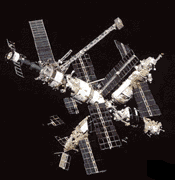Mir Space Station
 The Soviet manned space program has emphasized long term occupancy of low Earth orbit since the first Salyut space station was launched in 1971. Mir is the successor to the Salyut series of vehicles (8 total), and is the largest space station ever orbited.
The Soviet manned space program has emphasized long term occupancy of low Earth orbit since the first Salyut space station was launched in 1971. Mir is the successor to the Salyut series of vehicles (8 total), and is the largest space station ever orbited.
Designed as a modular system, Mir (meaning "peace") consists of 6 different spacecraft modules mated together in orbit. The core vehicle, launched in 1986, is the backbone of the station and contains the basic living/working quarters and station control facilities. The other modules (Kvant 1, Kvant 2, Kristall, Spektr, Priroda) were launched later, and added major scientific capabilities and/or improved living/working facilities to the core vehicle. The facility has been permanently manned since September 1989 and has hosted numerous international visitors. A special module, added in 1995, allows the Space Shuttle to dock at the station to support collaborative efforts with NASA (a total of 9 Shuttle/Mir rendezvous missions are planned in support of development of the International Space Station).
Originally planned for a 7 year mission, Mir was to be completed by 1990. However, repeated delays in the additional modules delayed completion of the station until 1996 when the sixth and final module (Priroda) was launched. At the end of the planned 7 years, only Kvant 1, Kvant 2, and Kristall had been orbited.
Investigations performed aboard the station include space technology experiments, remote sensing and environmental monitoring, life science and biological research, astrophysics studies, material processing tests, and medical and biotechnology experiments.
Life sciences experiments are primarily focused on the physical health of the Mir crews, including initial adaptation to the microgravity environment, physiological changes during short- and long-duration missions, and readaptation to the 1 g environment upon return to Earth. Other life science experiments have focused on the adaptation and maturation of various flora and fauna under low gravity conditions.
The station carries a large complement of Earth monitoring payloads, ranging from hand-held cameras to multispectral spectrometers and radiometers, to monitor the Earth's global environment. These payloads are used to monitor short and long-term changes in atmospheric, oceanographic, and land conditions.
Medical and biotechnology experiments have included protein crystal growth tests, blood purification experiments and interferon and anti-influenza research.
Mir space science investigations include gamma ray, X-ray, UV and IR observations of active galaxies, quasars and neutron stars, and observations of various solar-terrestrial phenomena and interactions.
The station's wide variety of space technology tasks have included the study of protective and construction materials for space use, the effects of the low Earth orbit environment on various materials such as ferromagnetics, polymers, and composites, and the manufacture of high purity materials in low-g materials processing furnaces.
Station resupply and personnel transfer is performed by Progress-M (cargo) and Soyuz-TM (manned) vehicles, which are upgraded versions of the previously proven Soyuz-T and Progress designs.
The station requires frequent EVA activity as part of its ongoing maintenance and operation. In addition to the installation and removal of scientific experiments on the exterior of the orbital facility, EVAs have been used to repair numerous harware problems (e.g., a docking problem with the Kvant 1 module, a malfunctioning rendezvous antenna, an Soyuz-TM thermal control system), to test manned maneuvering suits, and to upgrade station capabilities (e.g., installing additional solar arrays).
The station's low Earth orbit varies between 300-400 km, with an inclination of 51.6 degrees. As the station decays due to atmospheric drag, propulsive maneuvers are used to boost the station back into a safer orbit. These propulsive maneuvers can be performed by the station itself or by visiting Soyuz-TM and Progress-M vehicles as a means of advantageously using any excess fuel reserves remaining on the vehicles after docking.
Further information about Mir can also be found at the NASA Mir Page
Related QuickLook Pages:
Launch Facts
| Name | Int'l Desig. | Date | Site | Vehicle | Orbit | Mass(kg) |
| Notes | ||||||
| Mir Core Module | 1986-017A | 2/19/86 | Tyuratam | SL-13 | LEO | 20100 |
| Space station core module | ||||||
| Kvant 1 | 1987-030A | 3/31/87 | Tyuratam | SL-13 | LEO | 20000 |
| MIR module; high energy observatory | ||||||
| Kvant 2 | 1989-093A | 11/26/89 | Tyuratam | SL-13 | LEO | 19565 |
| Mir expansion module | ||||||
| Kristall | 1990-048A | 5/31/90 | Tyuratam | SL-13 | LEO | 19640 |
| Mir module; materials processing laboratory | ||||||
| Spektr | 1995-024A | 5/20/95 | Tyuratam | SL-13 | LEO | 19640 |
| MIR experiment module | ||||||
| Priroda | 1996-023A | 4/23/96 | Tyuratam | SL-13 | LEO | 19000 |
| Remote sensing module for Mir space station | ||||||
Information in The Mission and Spacecraft Library is provided without warranty or guarantee. USE AT YOUR OWN RISK.